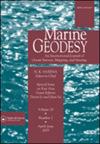A Nonlinear Gauss-Helmert Model and Its Robust Solution for Seafloor Control Point Positioning
IF 1.4
4区 地球科学
Q2 GEOCHEMISTRY & GEOPHYSICS
引用次数: 0
Abstract
Abstract Using GNSS-Acoustic (GNSS-A) technology to establish the seafloor geodetic datum is both feasible and flexible and thus has become an important way to obtain the absolute positions of seafloor control points. However, numerous errors are inevitable in marine surveying, including systematic errors and gross errors caused by GNSS dynamic positioning, inaccurate sound velocity profile measurements, and ocean ambient noise, and their interference will be directly reflected in the positioning results. To accurately calculate the seafloor control point coordinates, this paper first notes that the general error propagation law (EPL) method is defective in dealing with various error factors in GNSS-A positioning. A more rigorous method incorporates the time-varying term of the sound velocity ranging error into the coefficient matrix of the underwater observation equation, and the transducer position error should be considered. Therefore, a Gauss-Helmert (GH) model is used for seafloor control point positioning. Then, considering the dual nonlinearity of the model, a Lagrange objective function is constructed to derive its solution algorithm. On this basis, considering the gross errors polluting of the observations, the robust estimation principle is introduced, and the robust solution steps are given. Finally, simulation experiments and a testing experiment in the sea area near Jiaozhou Bay are used to verify the performance of the new method. The results show that the functional relationship and stochastic model of the nonlinear GH model for seafloor point positioning are reasonably described. Under ideal conditions with no gross errors and either different water depths or different transducer position errors, the accuracy and stability of the new method are both higher than those of the EPL method. When the observations are polluted by gross errors, the robust algorithm of the new method can accurately identify the abnormal information. By improving the robustness of the observation and structure spaces, the positioning precision of the 3D point deviation results can be optimized, and the solution performance of the new method is superior to that of the general method.海底控制点定位的非线性Gauss-Helmert模型及其鲁棒解
利用GNSS-Acoustic (GNSS-A)技术建立海底大地基准具有可行性和灵活性,已成为获取海底控制点绝对位置的重要途径。然而,在海洋测量中不可避免地会出现许多误差,包括GNSS动态定位引起的系统误差和粗误差、声速剖面测量不准确、海洋环境噪声等,这些误差的干扰会直接反映在定位结果中。为了准确计算海底控制点坐标,本文首先指出一般误差传播律(EPL)方法在处理GNSS-A定位中各种误差因素时存在缺陷。更为严格的方法是将声速测距误差的时变项纳入水下观测方程的系数矩阵中,并考虑换能器位置误差。因此,采用高斯-赫尔默特(GH)模型进行海底控制点定位。然后,考虑模型的对偶非线性,构造拉格朗日目标函数,推导其求解算法。在此基础上,考虑了观测值的粗误差污染,引入了鲁棒估计原理,给出了鲁棒求解步骤。最后,通过仿真实验和胶州湾附近海域的测试实验,验证了新方法的性能。结果表明,非线性GH模型的函数关系和随机模型得到了合理的描述。在无粗误差、不同水深和不同换能器位置误差的理想条件下,新方法的精度和稳定性均高于EPL方法。当观测值受到粗误差污染时,新方法的鲁棒性算法能准确识别异常信息。通过提高观测空间和结构空间的鲁棒性,可以优化三维点偏差结果的定位精度,且新方法的求解性能优于一般方法。
本文章由计算机程序翻译,如有差异,请以英文原文为准。
求助全文
约1分钟内获得全文
求助全文
来源期刊

Marine Geodesy
地学-地球化学与地球物理
CiteScore
4.10
自引率
6.20%
发文量
27
审稿时长
>12 weeks
期刊介绍:
The aim of Marine Geodesy is to stimulate progress in ocean surveys, mapping, and remote sensing by promoting problem-oriented research in the marine and coastal environment.
The journal will consider articles on the following topics:
topography and mapping;
satellite altimetry;
bathymetry;
positioning;
precise navigation;
boundary demarcation and determination;
tsunamis;
plate/tectonics;
geoid determination;
hydrographic and oceanographic observations;
acoustics and space instrumentation;
ground truth;
system calibration and validation;
geographic information systems.
 求助内容:
求助内容: 应助结果提醒方式:
应助结果提醒方式:


